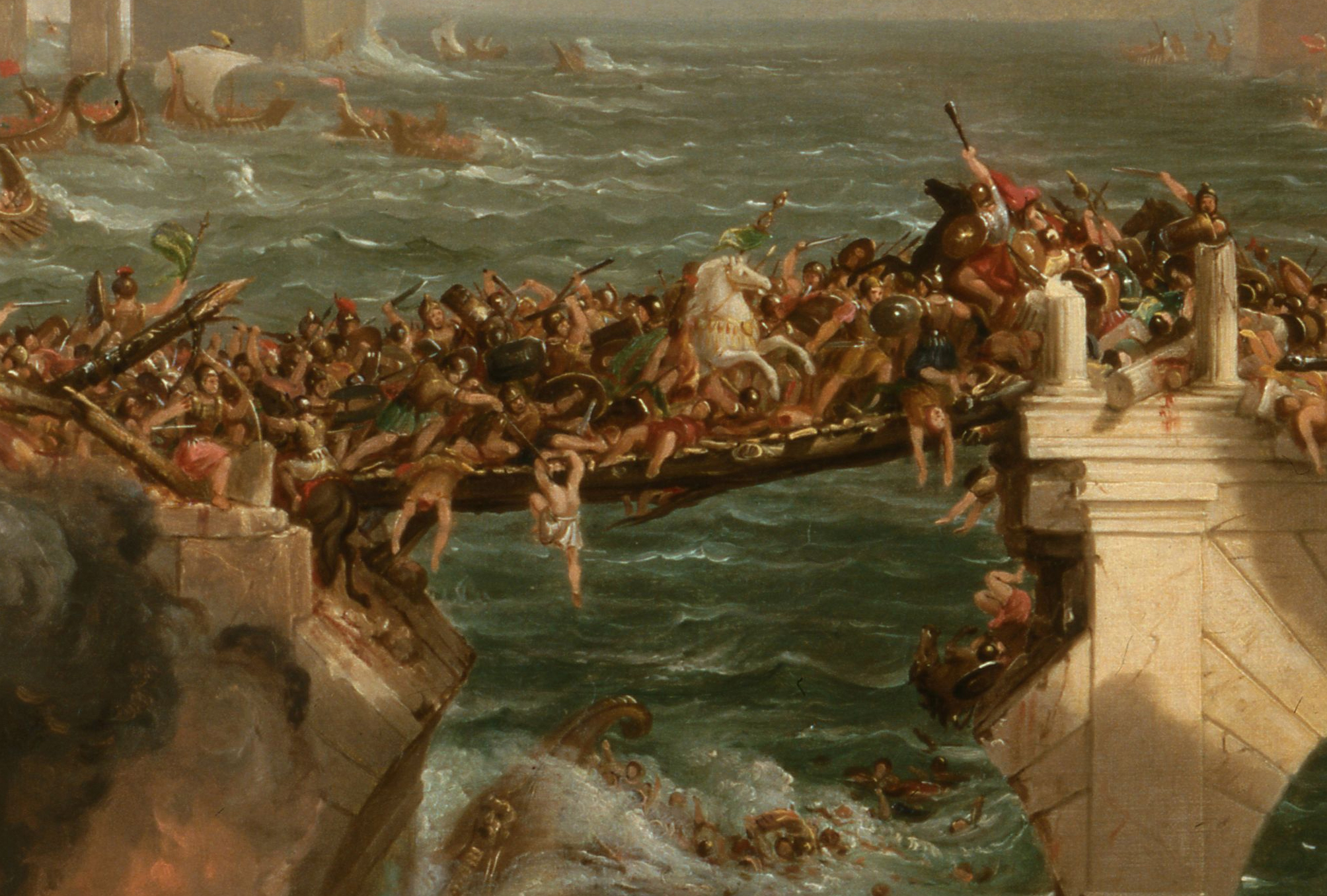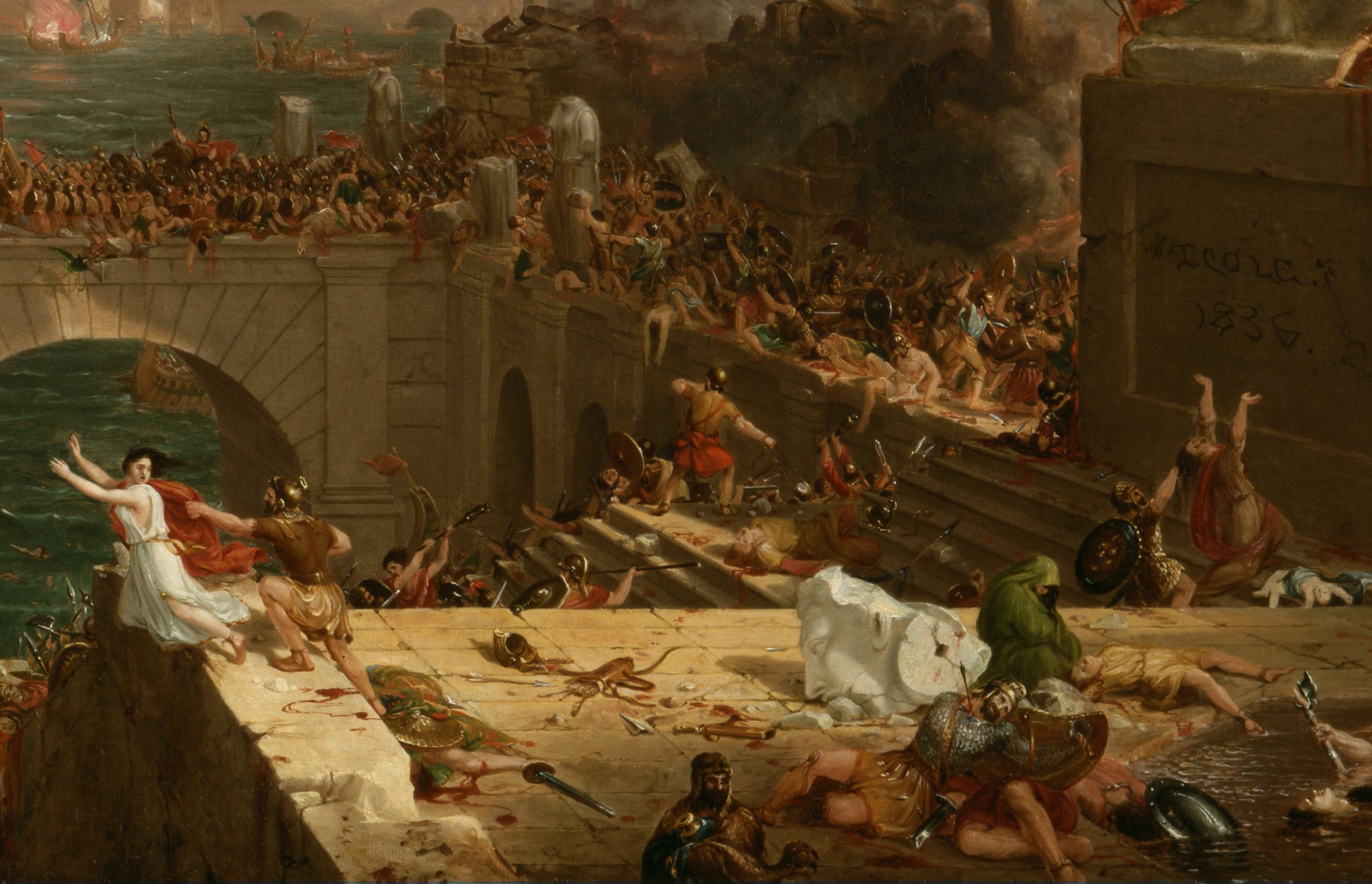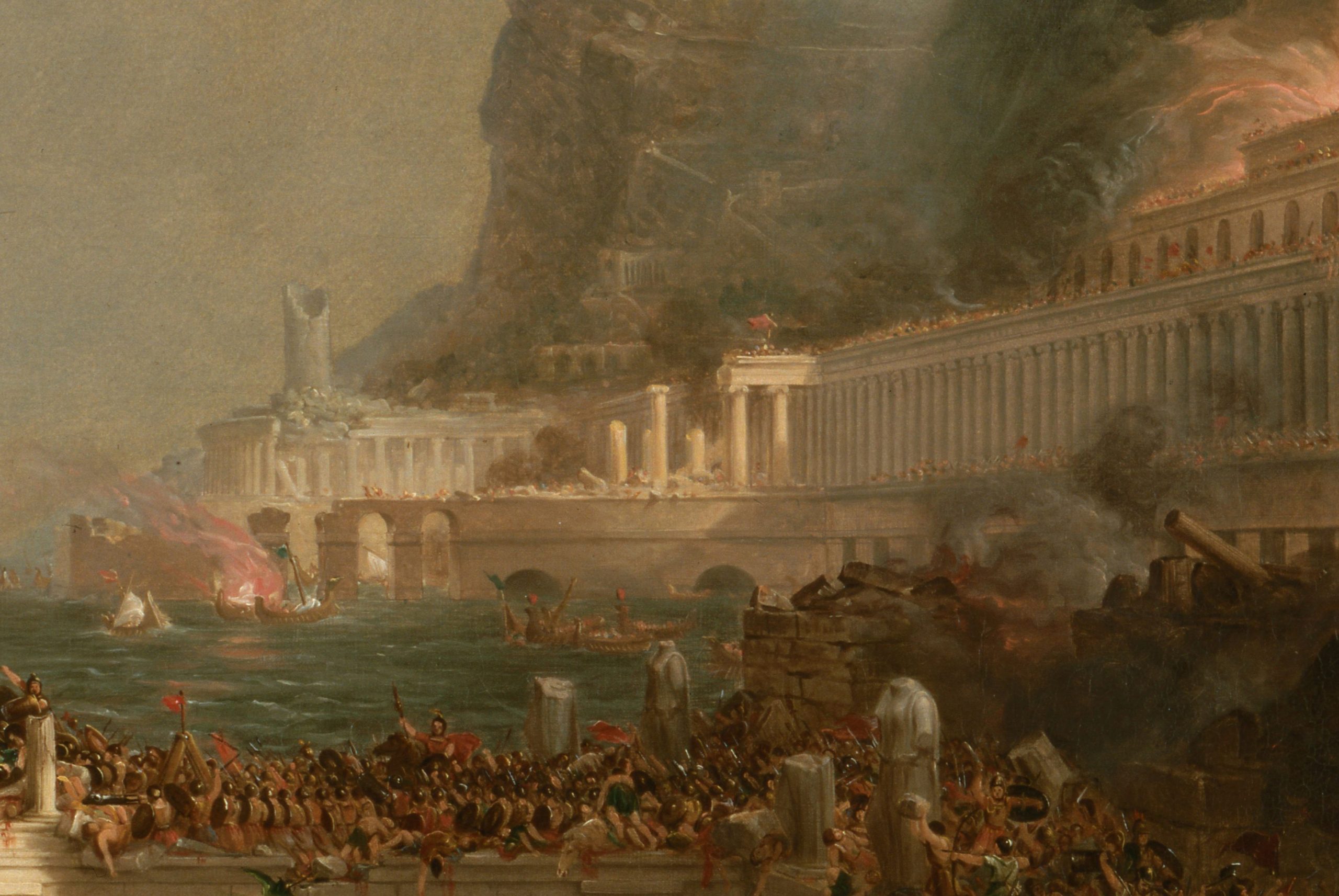The Course Of Empire - Destruction
The Course Of Empire - Destruction - The mountain becomes more visible again, asserting the return of nature. In it, cole presented a cyclical view of history in which a civilization appears, matures, and collapses. Web the course of empire: (134.6 × 194.3 × 14.6 cm) The consummation of the empire • 1836 the oxbow • 1836 the departure • 1838 il penseroso • 1845 the vesper hymn • xix cent. (84.5 × 160.7 cm) credit line: Web cole's words locate thomas cole, the course of empire: Web the course of empire: The 1830s were an optimistic time in america. Web politics the course of empire starting in 1833 thomas cole spent 3 years creating the course of empire, a series of five paintings describing the arc of human culture from ‘savage wilderness’ through high civilization and its inevitable destruction. In the resulting series, the course of empire, cole presented a cyclical view of history in which a. Web cole's words locate thomas cole, the course of empire: 33 1/4 × 63 1/4 in. 39 1/4 × 63 1/2 in. Destruction comes second to last in the series, which charts the rise and decline of an imaginary empire. Destruction —for a series titled the course of empire (1836). It is notable in part for reflecting popular american sentiments of the times, when many saw pastoralism as the ideal phase of human civilization, fearing that empire would lead to gluttony and inevitable decay. The poem alludes to five states of civilization and the implicit prophecy that america would prove. Web the resulting series consists of the savage state, the arcadian or pastoral state, the consummation of empire, destruction, and desolation. In the resulting series, the course of empire, cole presented a cyclical view of history in which a. Web the course of empire: View all 143 artworks related artworks court métrage short films. Destruction thomas cole 1836, oil on. Web the course of empire: The painting depicts the destruction of an ancient empire, modelled after the ancient empire of the mediterranean. It is notable in part for reflecting popular american sentiments of the times, when many saw pastoralism as the ideal phase of human civilization, fearing that empire would lead to gluttony and inevitable decay. Web cole's words locate. The arcadian or pastoral state; Desolation • 1836 the course of empire: Destruction comes second to last in the series, which charts the rise and decline of an imaginary empire. A colossal figure, modeled on the borghese warrior, witnesses the rapacious acts of the invading army. Destruction thomas cole 1836, oil on canvas The arcadian or pastoral state; Web thomas cole‘s the course of empire is an epic five piece telling of the rise and fall of rome. The image is in the public domain, and tagged allegory, the course of empire and war. The painting depicts the destruction of an ancient empire, modelled after the ancient empire of the mediterranean. In it,. It was painted in 1836 ce and is part of the collection of new york historical society. Web the course of empire: If you’re a new yorker, you’re in luck! (134.6 × 194.3 × 14.6 cm) Web it is evident that the sack of rome directly inspired the scene in 455, when the roman empire had been plummeting for decades,. Web in 1833 thomas cole secured a commission from new york merchant luman reed to paint a cycle of five paintings for the art gallery in his home. Web the resulting series consists of the savage state, the arcadian or pastoral state, the consummation of empire, destruction, and desolation. Web the vainglorious city that cole depicted in the consummation of. Nature echoes the chaos of the empire's destruction in the form of storm clouds, wind, and fire. Web it is evident that the sack of rome directly inspired the scene in 455, when the roman empire had been plummeting for decades, and the desecration of its outstanding capital was the final blow to. The porch of the doric temple becomes. 33 1/4 × 63 1/4 in. Desolation • 1836 the course of empire: Cole created a magnificent cycle of five paintings called the course of empire, which tells the story of an empire through its rise and fall. In it, cole presented a cyclical view of history in which a civilization appears, matures, and collapses. Web cole's words locate thomas. Web the resulting series consists of the savage state, the arcadian or pastoral state, the consummation of empire, destruction, and desolation. Destruction comes second to last in the series, which charts the rise and decline of an imaginary empire. The savage state, the arcadian or pastoral state, the consummation of empire, destruction, and desolation. A colossal figure, modeled on the borghese warrior, witnesses the rapacious acts of the invading army. Web discussed in biography in thomas cole.empire: The painting depicts the destruction of an ancient empire, modelled after the ancient empire of the mediterranean. The arcadian or pastoral state; Web politics the course of empire starting in 1833 thomas cole spent 3 years creating the course of empire, a series of five paintings describing the arc of human culture from ‘savage wilderness’ through high civilization and its inevitable destruction. Desolation • 1836 the course of empire: Destruction 1836 oil on canvas unframed: Destruction, oil on canvas, 1836, 39 ½ x 63 ½ in. Nature echoes the chaos of the empire's destruction in the form of storm clouds, wind, and fire. The consummation of the empire • 1836 the oxbow • 1836 the departure • 1838 il penseroso • 1845 the vesper hymn • xix cent. Destruction is a hudson river school oil on canvas painting created by thomas cole in 1836. Web thomas cole, the course of empire: Web the course of empire:
The Course Of Empire Destruction By Thomas Cole Print or Oil Painting

Narrative Painting Thomas Cole, The Course of Empire Destruction, 1836

Thomas Cole, The Course of Empire The Destruction, oil on… Flickr

Narrative Painting Thomas Cole, The Course of Empire Destruction, 1836

The Course Of Empire Destruction By Thomas Cole Print or Oil Painting

Cole_Thomas_The_Course_of_Empire_Destruction_1836 (1) Academy of Ideas

Thomas Cole The Course of Empire Destruction. Detail. 1836. Oil on

350pxCole_Thomas_The_Course_of_Empire_Destruction_1836 Capitalism

"The Course of Empire (Destruction)" by Thomas Cole [4355x2768

Narrative Painting Thomas Cole, The Course of Empire Destruction, 1836
Web In 1833 Thomas Cole Secured A Commission From New York Merchant Luman Reed To Paint A Cycle Of Five Paintings For The Art Gallery In His Home.
In It, Cole Presented A Cyclical View Of History In Which A Civilization Appears, Matures, And Collapses.
Web Famous Works The Garden Of Eden • 1828 The Titan`s Goblet • 1833 The Course Of Empire:
(84.5 × 160.7 Cm) Credit Line:
Related Post: